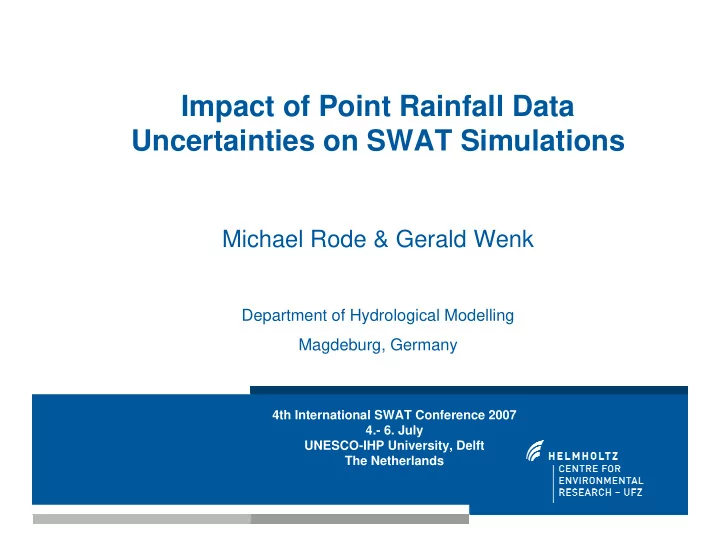

Impact of Point Rainfall Data Uncertainties on SWAT Simulations Michael Rode & Gerald Wenk Department of Hydrological Modelling Magdeburg, Germany 4th International SWAT Conference 2007 4.- 6. July UNESCO-IHP University, Delft The Netherlands
Motivation • Input data uncertainties are increasingly recognised • Rainfall data are most important input data for rainfall runoff models • Point rainfall data are associated with systematic and random errors Seite 2
Systematic point rainfall measurement errors •Mean correction (%) of the average annual precipitation total (1961/90) •Moderate wind-sheltered sites in Germany Source: (WMO, 1998) Seite 3
Mean correction (%) of precipitation in the Weiße Elster River Basin Shelter Jan Feb Mar Apr May Jun Jul Aug Sep Oct Nov Dec Year class a 31.6 33.5 26.9 18.3 12.5 10.4 10.8 10.5 12.6 15.5 21.8 26.5 18.2 b 23.3 24.5 20.3 15.1 11.2 9.8 10.0 9.5 11.5 12.7 16.8 19.8 14.6 c 17.3 17.9 15.5 12.7 10.1 8.8 9.1 8.5 10.2 11.0 13.3 15.0 12.0 d 11.5 11.8 10.7 10.0 8.6 7.7 8.0 7.5 8.7 8.8 9.5 10.3 9.3 Time series 1961/90, according to Richter (1995) Seite 4
Objectives • Investigate the impact of systematic and random rainfall point measurement errors • Assess simulated discharge and nitrogen with SWAT • Analyse scaling effects of these errors Seite 5
The Weisse Elster Basin: Study area Overview Catchment area: 5360 km² River length: 253 km Mean discharge: 25.2 m 3 /s Rainfall gauge stations: 49 Discharge gauge stations: 18 Land use Agricultural land: 62% Forest: 23% Urban areas: 13% Seite 6
Methodological approach •Add randomly generated correctionvalues to uncorrected rainfall measurement values •Assume Gumbel error distribution of PDFs •Standard deviations of PDFs are defined by the correction factor •Generate 200 time series for each rainfall gauge station (DUE) •Compare SWAT simulations with respect to variables and scales Seite 7
Data Uncertainty Engine (DUE) •Characterisation and assessment of uncertainty in data •Generates time series including systematic and random errors •Monte Carlo based approach using pdf’s Seite 8
Calibration discharge gauge stations N Oberthau � m C D G a h e n o h a g e a u g e � Thekla c s s c s � � � � t t f r � � i � � � � � Restgebiet � � � � W E R B � n h e e e e e a n s s s v s t t r r i i l i i � � � W S A C u e d o T a b a o n � s f r - r t l i i � � � � � � � Catchment of Discharge Gauge � � Kleindalzig � � � � Adorf � Böhlen � � Böhlen Zeitz Gera-Langenberg � Greiz � Gößnitz � � � � Kleindalzig Gera-Langenberg Läwitz � � Gößnitz � � � Oberthau � Restgebiet � � Straßberg � � � � � � � � Thekla Greiz Läwitz Zeitz � � Rivers � � � Discharge Gauge � � � Water Quality Gauge Straßberg � � m 0 1 0 2 0 3 0 4 0 5 0 K o e e s i l t r Adorf Seite 9
SWAT calibration discharge gauge station Läwitz (98 km²) 7 •Reasonable Discharge Läwitz (obs.) Discharge Läwitz (sim.) 6 calibration results 5 •Problems to Discharge [m³/s] represent the 4 discharge dynamics 3 2 1 0 01.11.1996 01.03.1997 01.07.1997 01.11.1997 01.03.1998 01.07.1998 Seite 10
SWAT calibration discharge gauge station Zeitz (2504 km²) 140 Discharge Zeitz (obs.) Discharge Zeitz (sim.) 120 100 Discharge [m³/s] 80 60 40 20 0 01.11.1997 01.05.1998 01.11.1998 01.05.1999 01.11.1999 01.05.2000 Seite 11
SWAT calibration of DIN load, gauge station Gera-Langenberg (2186 km²) Gera-Langenberg •Reasonable agreement 80 between observed and measured simulated simulated DIN loads DIN - load [t/d] 60 •Slightly overestimated nitrogen loads 40 •Oversimplified represen- tation of nitrate denitrifi- 20 cation in the aquifer 0 Oct-95 Apr-96 Oct-96 Apr-97 Oct-97 Apr-98 Oct-98 date Seite 12
Mean simulated discharge using four different correction factors •Systematic errors 125 of mounthly values ������ Mean (9,3 %) Mean (12,0 %) •Large differences Mean (14,6 %) 100 in the case of low Mean (18,2 %) runoff [mm/month] flows 75 50 25 0 1990 1992 1994 1996 1998 2000 Seite 13
Mean simulated discharge using four different correction factors •Comparable 100 Gera-Langenberg differences Mean (9,3 %) Mean (12,0 %) with increasing Mean (14,6 %) catchment size Mean (18,2 %) 75 runoff [mm/month] 50 25 0 1990 1992 1994 1996 1998 2000 Seite 14
Mean simulated nitrogen using four different correction factors •Small effects on simulated 15,0 Läwitz nitrogen loads Mean (9,3 %) Total Nitrogen Load [kg/(ha*month)] Mean (12,0 %) 12,5 Mean (14,6 %) Mean (18,2 %) 10,0 7,5 5,0 2,5 0,0 1990 1992 1994 1996 1998 2000 Seite 15
Mean and maximum monthly error ranges of simulated discharge •Correction factor of 50 Mean (Range) 18.2% Max (Range) 40 •Randomly generated Discharge [mm/month] rainfall time series 30 •Gumbel distribution 20 •Decrease of errors with increasing rainfall 10 gauge stations 0 0 10 20 30 40 50 Number of Weather Stations Seite 16
Mean and maximum monthly error ranges of simulated nitrogen •Considerable mean Mean (Range) 5 Max (Range) errors only when using Total Nitrogen Load [kg/(ha*month)] small numbers of 4 stations 3 •Maximum errors in single month can still 2 be significant 1 0 0 10 20 30 40 50 Number of Weather Stations Seite 17
Conclusions • Systematic rainfall measurement errors can have considerable impact on simulated discharge and nitrogen • These errors can be increased by random rainfall errors • Effect of random error rapidly decreases with increase rainfall stations • Nitrogen load calculations are much less sensitive to random precipitation errors than simulated discharge Seite 18
Recommend
More recommend